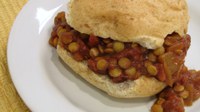Prairie Fare: Freezer Meals Speed Summertime Cooking
(Click an image below to view a high-resolution image that can be downloaded)
By Julie Garden-Robinson, Food and Nutrition Specialist
NDSU Extension Service
As I was driving with the window open in my vehicle, the scent of freshly mown grass reminded me that summer is almost here. A little later, my nose detected another sensory delight of spring: the aroma of grilling food.
Although you might be expecting an article about grilling with that opener, I’d like to take us back to winter temperatures. Besides using your grill, how about using your freezer to store some homemade ready-to-cook or ready-to-heat-and-eat freezer meals?
Many people like to ease up on time in the kitchen when the weather allows us to enjoy our gardens and other outdoor activities. Freezer meals can help.
Freezer meals are the product of a term known as freezer cooking. The basic concept of freezer cooking is that you spend one day preparing a large quantity of meals that will feed you or your family for two weeks up to two months.
A wide range of freezer meal recipes are available on the internet, but not all of them are equally nutritious. Look for recipes that provide nutrition information.
Meals are prepared assembly-style, packaged, labeled and frozen. Depending on how many freezer meals you prepared, you shouldn’t have to prepare the main entrée again for the next two weeks or a month.
You can save time and potentially money, plus have control over the ingredients in your foods, if you make your own freezer meals. Assembly-style processing saves you time; instead of chopping one onion for each recipe as you need it, you might chop 10 onions at one time and be able to use them for multiple recipes. Even better: You only have to clean up once.
When you are preparing several recipes at once, you may be able to take advantage of buying ingredients in bulk. Bulk purchasing typically provides a lower price per unit on items when you buy them in large quantities.
Freezer storage makes meals convenient. Simply remove a package the night before to thaw in the refrigerator and reheat or cook for your evening meal the next day. Additionally, when you have easy-to-prepare meals on hand, you are less likely to order take-out or visit the fast-food drive through when you get hungry.
If you never have done any freezer cooking, start small and gradually increase. Try a few meals that you know your family will eat, or try a plan for two weeks’ worth of meals if you feel ready. This should take you only about half a day or less to prepare, and the meals can fit in a refrigerator-top freezer.
Remember that certain foods will not reheat well after being frozen. Lettuce, watermelon and tomatoes will become limp. Cooked potato chunks will become gritty. Fully cooked pasta may be mushy. Gravies and some dairy products such as cream or milk will separate when frozen. Cooked eggs may become rubbery.
Even if you have a small freezer, freezer meals still can be an option for you. By getting creative and freezing meals flat, you can store about two weeks’ worth of meals in a refrigerator-top freezer. Once meals are frozen, you can reorganize them so they are stacked vertically like a bookshelf if your freezer allows.
Avoid freezer-burn by using a freezer zip-top plastic bag and making sure to remove as much air as possible before sealing. Storing food in smaller quantities allows it to freeze more quickly and gives you the ability to take out only what you need.
Use a permanent marker to label all food that goes into the freezer so you know what it is. Also include a use-by date (most food will stay good for two to three months from the date it was prepared) and any preparation steps needed to cook the food. That way you don’t have to dig for the recipe when you are ready to cook.
Arrange containers in a single layer so air can circulate and help the food freeze quickly. The faster the food freezes, the better the quality will be when it thaws. Defrost food in the microwave or refrigerator. Thawing foods at room temperature increases the risk of bacterial contamination.
We recently completed a freezer meals handout with several recipes incorporating “pulse foods” (lentils, dry peas and chickpeas) in honor of the International Year of Pulses in 2016. Pulse foods are good sources of fiber, protein, and many vitamins and minerals. See “On the Pulse of Healthful Eating: Making Freezer Meals With Lentils, Chickpeas and Split Peas” (at https://www.ag.ndsu.edu/pubs/yf/foods/fn1787.pdf) for a variety of recipes and more tips about freezer meals.
Here’s a different take on the old standard sloppy joes.
Slow Cooker Sloppy Lentils Freezer Meal
1 c. lentils, dry (cooked according to package directions)
1 onion, diced
1 (14.5-ounce) can diced tomatoes, drained
1 (6-ounce) can tomato paste, unsalted
1 clove garlic, minced
1/2 c. ketchup
1 tsp. mustard powder
1 Tbsp. chili powder
3 Tbsp. molasses or honey
1 Tbsp. vinegar
1 c. chicken broth (add at cooking time)
To freeze: Cook lentils according to package directions. Chop vegetables. Add ingredients to a labeled freezer bag.
To cook: Remove from freezer and place in the refrigerator overnight to thaw. Pour contents into a slow cooker along with 1 cup water or broth. Cook on low five hours.
To serve: Serve on whole-wheat buns or bread.
Makes 14 (1/4-cup) servings. Each serving has 90 calories, 0.5 gram (g) fat, 4 g protein, 18 g carbohydrate, 3 g fiber and 190 milligrams sodium.
(Julie Garden-Robinson, Ph.D., R.D., L.R.D., is a North Dakota State University Extension Service food and nutrition specialist and professor in the Department of Health, Nutrition and Exercise Sciences.)
NDSU Agriculture Communication - May 5, 2016
| Source: | Julie Garden-Robinson, 701-231-7187, julie.garden-robinson@ndsu.edu |
|---|---|
| Editor: | Ellen Crawford, 701-231-5391, ellen.crawford@ndsu.edu |



